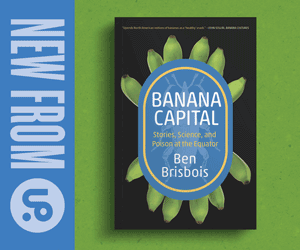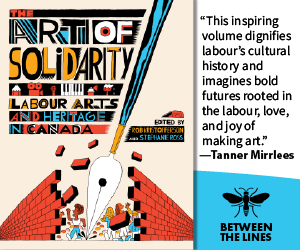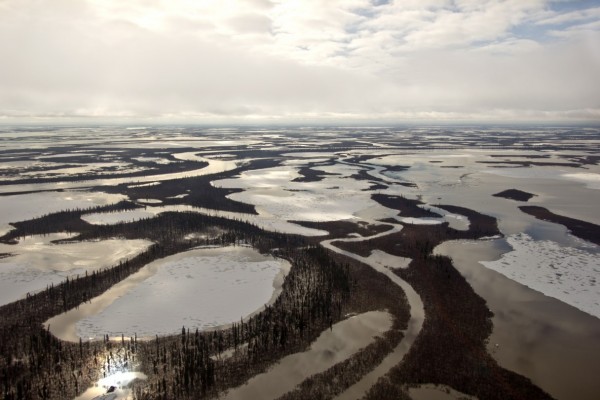Climate capitalism and ‘regimes of obstruction’
Two new books expose the forces holding us back from real climate action in Canada

A pump jack operates in an oil field in the Permian Basin in Texas. Photo by Jacob Ford/Odessa American.
Climate inaction is infuriating.
We’re already experiencing the harms of global warming, emissions keep going up, and Canadian governments at nearly every level tell us they have it under control, and that they are responding appropriately.
While there are thankfully an increasing number of serious books proposing what can be done to actually meet the scale of the crisis we face (including Seth Klein’s A Good War and Max Ajl’s A People’s Green New Deal), it is still worth giving a nod to the essential works that expose the forces holding us back from climate action in Canada—especially because these works get little attention from mainstream media.
Two books, ideally read in sequence, go a long way to explaining what has been happening. The first, easier-to-read text is The Big Stall: How Big Oil and Think Tanks are Blocking Action on Climate Change in Canada, by Donald Gutstein, published in 2018 by Lorimer. The second is the multi-authored academic collection, Regime of Obstruction: How Corporate Power Blocks Energy Democracy, edited by William K. Carroll, and published this April by University of Athabasca Press.
In full disclosure, I worked for Lorimer in 2020, and am currently involved in a project receiving funding from the Corporate Mapping Project, which funded research published in Regime of Obstruction.
In The Big Stall, retired communications professor Donald Gutstein impressively pieces together the long-term and more recent tale of climate inaction.
To tell the long story, Gutstein traces the trajectory of Maurice Strong, a personality who almost perfectly exemplifies the intertwined nature of fossil fuel interests and environmental policy. Strong was in the oil business in the 1950s, becoming an executive and then owner of a major company in Alberta before rising to the role of president of the Québec -based Power Corporation in the 1960s. The Power Corporation is one of the biggest management and holding companies in Canada, and is well connected to the federal Liberals.
While at the Power Corporation, Strong hired an assistant by the name of Paul Martin (who went on to be a great ally of the oil industry in government). Then, in 1968, Liberal prime minister Lester Pearson tapped Strong to head the Canadian International Development Agency, which led him to interact with leaders of governments around the world.
This is where it gets interesting. In 1972, Strong chaired the first United Nations Conference on the Human Environment (also known as the Stockholm Conference), and then acted as executive director of the UN Environment Program until 1975. During this time, he was also a trustee of the Rockefeller Foundation, which was a driving force behind the infamous Trilateral Commission, pushing globalization and the opening of markets around the world for corporate exploitation. After his UN Environment stint, Strong was appointed by Prime Minister Pierre Trudeau to head the new government-owned oil company, Petro-Canada.
What explains Strong’s back-and-forth between environmental policy and the oil and gas industry? This has to be understood in the context of the rise of the modern environmental movement in North America. This began around the publication of Rachel Carson’s hugely popular book Silent Spring in 1962 and continued growing, with milestones including the founding of Greenpeace in 1971 and the publication of the Club of Rome’s Limits to Growth report in 1972. Environmentalism, its popularity and militancy, was a threat to the chemical, oil, gas, and coal industries. In particular, as environmental consciousness and protest flexed its political muscle, this began turning into stricter regulations and limitations on what companies in these industries could do. This was a new threat to the industry, along with its growth and profits.
Strong saw a way around. Gutstein has the receipts. He quotes Strong addressing the crowd in Stockholm in 1972, saying “There is no fundamental conflict between development and the environment.” This could easily be Justin Trudeau speaking in 2021.
The philosophy Strong was helping craft later crystalized around the term “sustainable development,” coined during the 1987 Bruntland Commission, of which Strong was a part.
Maurice Strong was a Canadian oil and mineral businessman and a diplomat who served as Under-Secretary-General of the United Nations. He was also tapped by Prime Minister Pierre Trudeau to head the government-owned oil company, Petro-Canada, from 1976-78. Photo from Wikimedia Commons.
The seductive idea behind sustainable development—at least the version pushed by politicians and industry globally—is that the unfair distribution of resources and dangerous levels of pollution in the present are not problems to be addressed directly. Instead, the proposed solution is to develop more and more resources, with promises of corporate responsibility to minimize negative impacts along the way, and to share benefits widely.
This, of course, suits the resource industries just fine, as long as there aren’t strict limits and regulations in place. To that end, the oil companies and their politician friends in Western nations did what they could to make sure emissions reductions activities stipulated in international agreements were voluntary, and targets were non-binding, not accompanied by penalties. By and large, they got their way, despite protests from politicians in the Global South, Indigenous peoples, and climate activists.
The chronology Gutstein presents takes up a whole book, and I don’t have the space here for all the details. But a major point he makes is, with the reality of climate change becoming increasingly clear and undesirable, it takes a lot of work to keep selling the public on the idea that fossil fuels extraction is a responsible thing to do. Because that work of persuasion is key to the continued existence of the industry, they’re willing to do it. This has ranged from suppression of scientific findings, to denial of the scientific consensus, through to what Gutstein calls “clean growth”—the hallmark of the Trudeau and Notley governments.
One side of the industry strategy has always involved getting the ear of government. To that end, perhaps no organization has been more effective than the Business Council of Canada, an organization made up of the CEOs of the largest companies in Canada. Specifically on climate, the Council had since 2007 called for a low price on carbon (a carbon tax) as a way to gain social license for continuing and expanding the fossil fuel industry. Then Canadian Prime Minister Stephen Harper didn’t bite, seemingly believing he knew better what was good for the private sector than they did.
And here we get to the shorter story Gutstein tells, about how the Trudeau and Notley governments failed to take decisive climate action but sold themselves as serious champions of the environment.
Before Trudeau’s election, he was on the same page as the Business Council. At the Calgary Petroleum Club in 2013, he told the high-powered crowd, “If we had stronger environmental policy in this country: stronger oversight, tougher penalties, and yes, some sort of means to price carbon pollution, then I believe the Keystone XL pipeline would have been approved already.”
Just after the Liberals 2015 election victory, the president of the Business Council, Paul Manley, a former Liberal cabinet minister and leadership candidate, wrote in iPolitics calling on Trudeau to enact responsible climate policy and facilitate the export of energy resources. Trudeau soon announced carbon pricing and the approval of the Trans Mountain Expansion and Line 3 export pipelines.
Another strategy, which Gutstein pays careful attention to, is the public battle over ideas. Oil companies know the public doesn’t see them as impartial or trustworthy on matters of science and public policy. But think tanks have more credibility, and a research centre connected to a university has even more. So oil companies have long sought out and supported those researchers and writers who come to conclusions that are supportive of industry’s aims.
A network of neoliberal think tanks, including the Fraser Institute and the now-defunct Energy Policy Institute of Canada, churned out industry-friendly studies, which often got picked up by mainstream media.
But the real credibility comes from universities. Among others, the University of Calgary’s School of Public Policy, with strong connections to the oil sector, has been highly influential in Alberta, and the University of Ottawa’s Smart Prosperity Institute (formerly Sustainable Prosperity, which got its start with help from the private sector), developed a close relationship on climate policy with the Trudeau Liberals since 2016. An economist favourable to the idea of a carbon tax and expanding the fossil fuel industry, Andrew Leach at the University of Alberta, was tapped by Notley’s NDP to help write the province’s climate plan.
To see how these actors work together in coordinated and uncoordinated ways to influence media, policy, and the shape of the country, The Big Stall is essential reading.
Regime of Obstruction is a much more academic book, contrasting The Big Stall’s clear and continuous narrative written for general readers. But for those willing to dig into Regime of Obstruction, and for university instructors looking to discuss the political economy of the fossil fuel sector with students, there is a lot there. In fact, the whole book is available online for free.
The chapters in Regime of Obstruction all start from different places and the authors have diverse research methods, but they all look in, like spokes around a wheel, at the fossil fuel industry in Canada and ask how it maintains its control in society to achieve its business goals, and thereby obstruct climate action. The authors also look at where resistance efforts are breaking that control apart.
Petro-Canada’s Edmonton Refinery and Distribution Centre, February 15, 2009. Photo by Dan Riedlhuber.
For example, political scientist Laurie Adkin shows how the majority of government-funded research grants in Alberta on energy and environment go towards studying oil and gas extraction processes, rather than, for example, how to transition to renewable energy. We see, from sociologist William Carroll and political scientist Jouke Huijzer, the close connections among board members of oil and gas and related companies in Alberta, the connection to Toronto finance, and also to industry associations, think tanks and universities.
Regime of Obstruction looks deeper on a few issues than The Big Stall does, and includes some topics that get scant mention in Gutstein’s book. While many oil companies play along with the Liberal and NDP game of saying they are serious about climate change, numerous companies have supported efforts to build pride in the industry among the general public, which often shows up as rhetoric trashing the carbon tax and environmentalists. Online, for example, the Canada’s Energy Citizens social media campaign of the Canadian Association of Petroleum Producers came to prominence at the end of the Harper era and kept growing through the Trudeau years. More independent groups (though with opaque funding) like Oil Sands Action, of “I HEART OIL SANDS” fame, have been even more viral on social media, and take certain anti-environmentalist liberties that an official industry campaign might shy away from. In person, support for the industry is looked at in oil-producing communities in Saskatchewan by geographer Emily Eaton and CCPA-Saskatchewan director Simon Enoch. They describe the how the oil and gas companies operating in the province target their philanthropy and provide what are often public services (like firefighting), such that people in the area come to see their interests and those of the industry as almost perfectly overlapping.
A weak point of both books is their limited investigations and analyses of Indigenous rights and the colonial project of accumulation by dispossession. However, there are a few points where Regime of Obstruction touches on this, including an eye-opening chapter on Indigenous labour in the oil and gas industry, by sociologists Angele Alook, Ian Hussey, and Nicole Hill, and a careful rumination on Indigenous resistance and buy-in to the industry in a chapter by SFU professor Cliff Atleo.
Regime of Obstruction also deepens the analysis of two key concepts: “new denialism” and “climate capitalism.” New denialism is essentially what Gutstein describes in The Big Stall as the promise of clean growth, the Liberal-led shift from full-on climate denial to a regime of admitting there is a problem, but then implementing completely inadequate responses while convincing people they are reasonable. The key result is that the fossil fuel industry continues on with business as usual, or as close to it as it can.
Climate capitalism is the logical extension of this new denialism. To quote Carroll in his conclusion to Regime of Obstruction:
This brings us to climate capitalism, an emergent accumulation strategy that ‘seeks to redirect investments from fossil energy to renewable energy generation so as to foster an ecological modernization of production and reduce greenhouse gas (GHG) emissions.’ The promise of climate capitalism is to shepherd the world to a safe landing without disrupting its essential nucleus in capitalist relations of pro-duction. However, the presence of major fossil-capital companies at the heart of the ‘climate capitalist corporate-policy elite’—that is, those corporate directors who also sit on climate and environmental policy groups—suggests ‘a weak project of climate capitalism,’ one in which the transition to sustainable energy production takes place relatively slowly. This gradual shift averts the threat of stranded assets while allowing fossil capital time to expand its control of replacement energy sources.
Readers may notice some of the research in Regime of Obstruction is several years old, and some chapters were previously published elsewhere. The book’s publication was bumped from 2020 to 2021, perhaps due to the pandemic. The main effect is a number of chapters feel like they were written at an earlier stage in the Trudeau years. More recent developments are not studied in depth, namely the Alberta UCP government of Jason Kenney, the “net zero” promises of the federal government and industry, and the widespread resistance by the Wet’suwet’en and their allies to the LNG Canada pipeline project in 2019 and 2020.
But we can use the analyses from these books to, for example, look behind the curtain of industry’s recent net zero promises and see the familiar face of climate capitalism at work. For more on these subjects, check out Kevin Taft’s Oil’s Deep State (Lorimer, 2017), and the climate sections of Martin Lukacs’ The Trudeau Formula (Black Rose Books, 2019).
Together, these books go a long way in helping us understand what has been happening. Having that knowledge doesn’t make the inaction any less infuriating, but it does help us see what we’re up against and where the regime of obstruction is vulnerable.
David Gray-Donald writes about climate justice, is an editor with the Media Co-op, was formerly the publisher of Briarpatch Magazine, works in the book publishing industry, and organizes on the topic of wealth redistribution with Resource Movement.










